The best deep fryer
The Cuisinart CDF-200 proved it can manage the heat better than most.
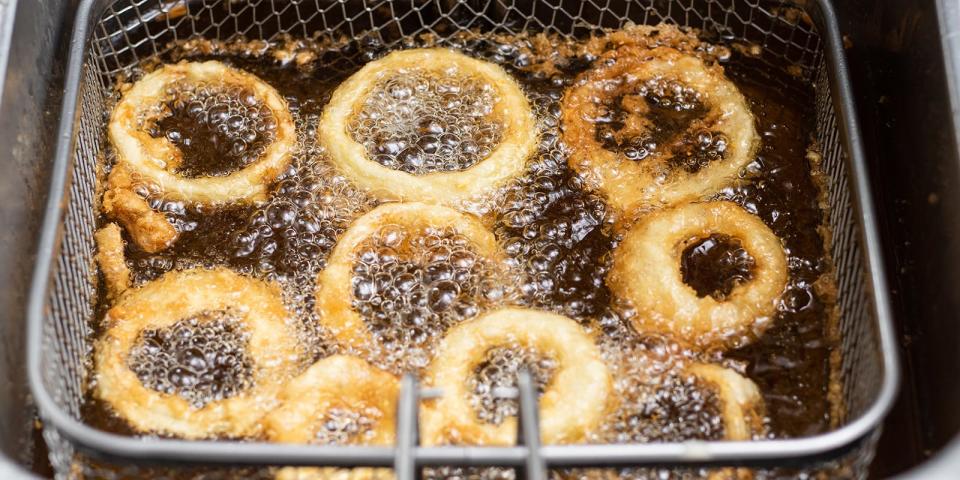
By Michael Sullivan
This post was done in partnership with Wirecutter. When readers choose to buy Wirecutter's independently chosen editorial picks, Wirecutter and Engadget may earn affiliate commission. Read the full deep fryer guide here.
After more than 60 hours of research and testing frying french fries, frozen chicken fingers, and beer-battered onion rings we think the Cuisinart CDF-200 is the best deep fryer for people who fry food often. It's easy to operate, and its heating element will keep oil at a set temperature better than most, producing crisp, golden brown foods. For occasional stovetop frying, we recommend the Lodge 6-Quart Enameled Dutch Oven and the ThermoWorks Dot probe thermometer. While a countertop fryer is a bit safer, a pot works just as well, takes up less space, and is much easier to clean.
The Cuisinart CDF-200 consistently produced perfectly crunchy, golden-brown food in our tests. It's the best deep fryer for anyone who fries a lot of food or wants a standalone machine for parties. The Cuisinart's reliable thermostat did a great job maintaining the set oil temperature, even after we added cold or frozen food. This model also has a clearly labeled temperature-control dial that ranges between 175 °F and 375 °F and a wind-up 30-minute timer that dings when the time is up. The Cuisinart's large frying basket provided plenty of space for tossing food and kept battered onion rings from clumping together in our tests.
If you don't fry food often, you don't need to get a dedicated deep fryer. Instead, we'd recommend using the Lodge Dutch Oven, which is more versatile, easier to store, and cooks food faster than a dedicated deep fryer. Frying with a pot of oil on the stovetop doesn't need to be scary. While it does take a bit more attention and finesse to keep track of the oil's temperature, you can easily monitor it using a probe thermometer with a pot clip or an inexpensive clip-on deep-fry thermometer. And while any large pot will do for frying, we prefer the 6-quart Lodge because it's heavy enough to help regulate the temperature of the oil and big enough to make two servings of fries at a time. Also, its light interior enamel coating makes it easy to see the color of the food you're frying and the quality of the oil. If you don't already have a Dutch oven in your kitchen arsenal, we think it's a worthwhile investment because it can be used for preparing everything from soups and stews to braises and sauces.
Why you should trust us
To help us find the best deep fryers to test, we spoke to Joseph Simon, head chef at Gracie Mansion and a former chef instructor at the International Culinary Center in New York City. For advice on eliminating frying odors, we also consulted Jolie Kerr, a cleaning expert and host of the podcast Ask a Clean Person.
Additionally, we read reviews from Business Insider and Foodal.com. Finally, we went to several stores, including Bed Bath & Beyond and Macy's, to look at deep fryers in person.
I have spent more than 60 hours researching, testing, and cleaning deep fryers for this guide. As a staff writer at Wirecutter, I have written reviews for all kinds of kitchen equipment and tabletop items, including air fryers, toaster ovens, and wine glasses.
Who should get a deep fryer
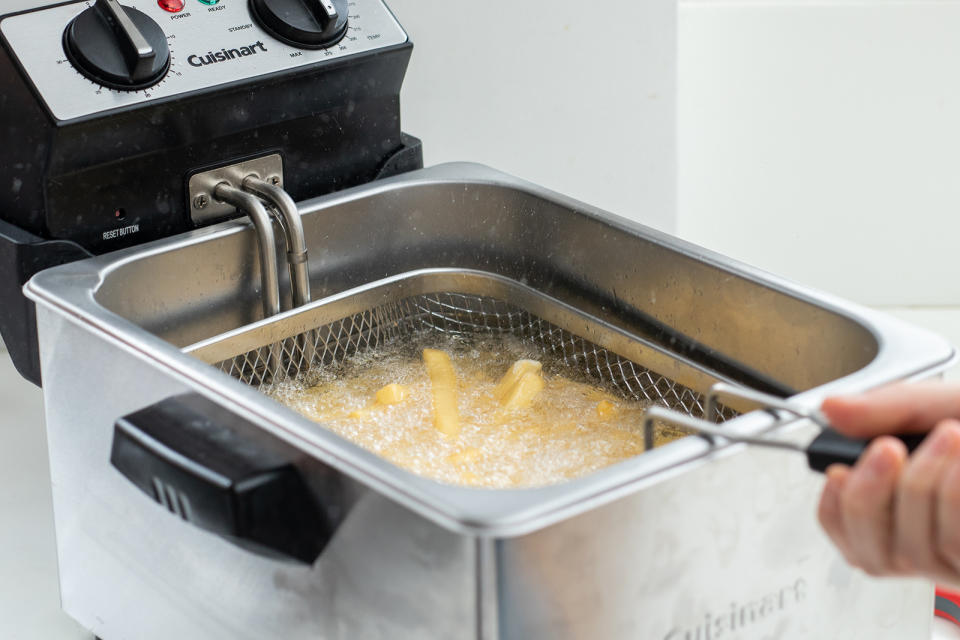
If you fry food weekly, or at parties and family gatherings, but you're intimidated by stovetop frying or it sounds like a hassle, you should consider getting a deep fryer. The main advantage to using a dedicated fryer (versus a pot of oil and a thermometer) is its built-in thermostat, which automatically monitors and adjusts the oil temperature. A deep fryer is also safer than using a pot of oil on the stovetop because it will automatically turn off if the oil is heated to dangerous temperatures. With stovetop frying, there's nothing to prevent the fat from reaching its flash point and catching fire if you accidentally leave the heat on high. Monitoring oil on an electric stovetop can also be tricky compared with using a countertop fryer, since the burner is slower to respond to temperature adjustments. Deep fryers clear up space that a pot of oil would otherwise hog on your stovetop, but they do take up a lot of room on a counter instead.
All that said, most people don't need to own a deep fryer. It's a single-use piece of equipment that's just as messy and smelly as using a pot of oil on the stovetop. The countertop models you can buy for home use don't compare to those used in professional kitchens, either they aren't as powerful and can't maintain the oil temperature as well. In fact, in our tests, the oil temperature dropped more when we added food to a deep fryer than when we used a pot of oil on the stovetop.
In contrast to a pot, a deep fryer has bigger pieces including the oil container, heating element, fryer basket, and lid that are more annoying and cumbersome to clean. Also, whether you're using a deep fryer or a pot on the stovetop, both methods require that the oil be filtered after each use if you plan to use it again. Otherwise, the oil will begin to break down, turn brown, and smell fishy. Filtering the oil is a tedious, labor-intensive task that probably won't inspire you to fry often, so keep that in mind if you think you want to get a deep fryer.
We think most people will be better off frying using equipment they already own in their kitchen. Here's what you'll need:
A large pot, such as a Dutch oven
A probe thermometer or deep-fry thermometer to monitor the temperature of the oil
A spider or large slotted spoon for removing fried food from the oil
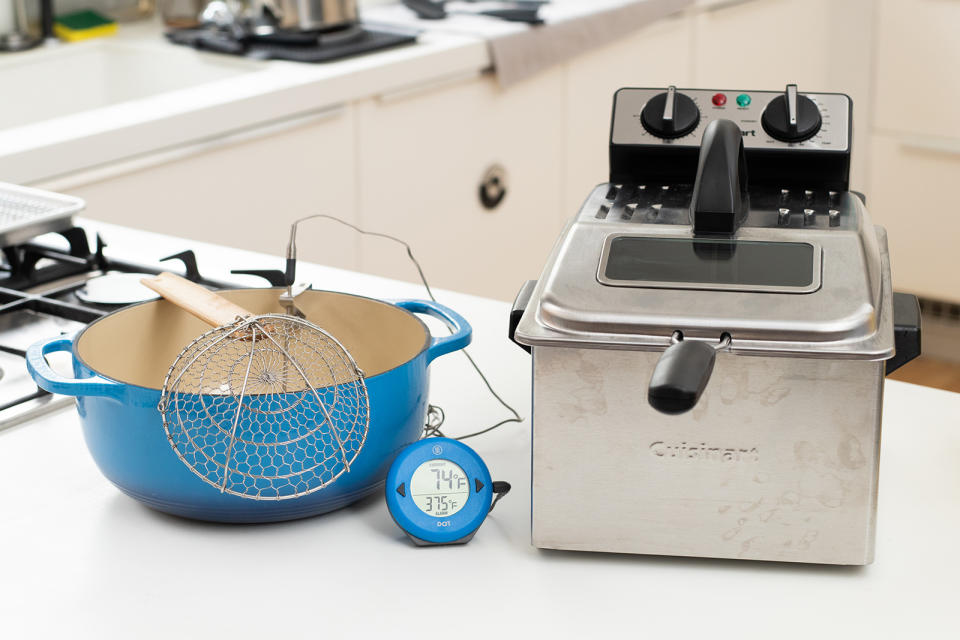
This equipment is far more versatile and useful than a fryer would be. As mentioned earlier, you can also make braises, soups, stews, sauces, and more with a Dutch oven. A probe thermometer lets you monitor the internal temperature of meats in the oven or on a grill, taking away the guesswork of knowing when they're done. It's also a great tool for more challenging tasks like making candy. And a spider or slotted spoon can be used for blanching vegetables, cooking pasta, or skimming stocks.
How we picked
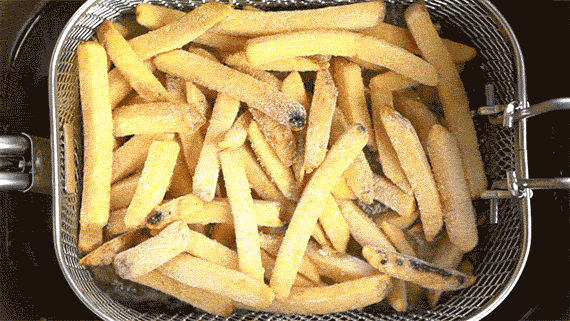
A deep fryer is not a complicated appliance. It's essentially a large tub for oil with a heating element submerged in it, which is regulated by an adjustable thermostat. So in choosing which models to test, we were only looking for a few straightforward requirements:
Generous capacity
We preferred fryers with a 4-quart oil capacity, which allows you to fry about two or three servings of food at once rather than having to cook several small batches. Smaller fryers with a 1 ½-quart capacity, such as the GranPappy, can accommodate only about one serving of french fries. If that's all you want to make, you're better off using a pot that's already in your kitchen. We also learned in our testing that the shape of a fryer is just as important as its capacity. A fryer that is wider versus taller means the oil level will be lower, and often too shallow to fully cover the food when frying.
Large frying baskets
Most 4-quart models come with an option of either one or three (one large and two small) frying baskets. Two small baskets allow you to keep different foods separate while frying at the same time, but we don't think that's necessary. If one item finishes cooking before the other, you can use tongs to remove it. The smaller baskets we tried were too cramped, especially for battered onion rings, which clumped together in our tests. The extra baskets also increase the total price of the machine and take up space in a cupboard.
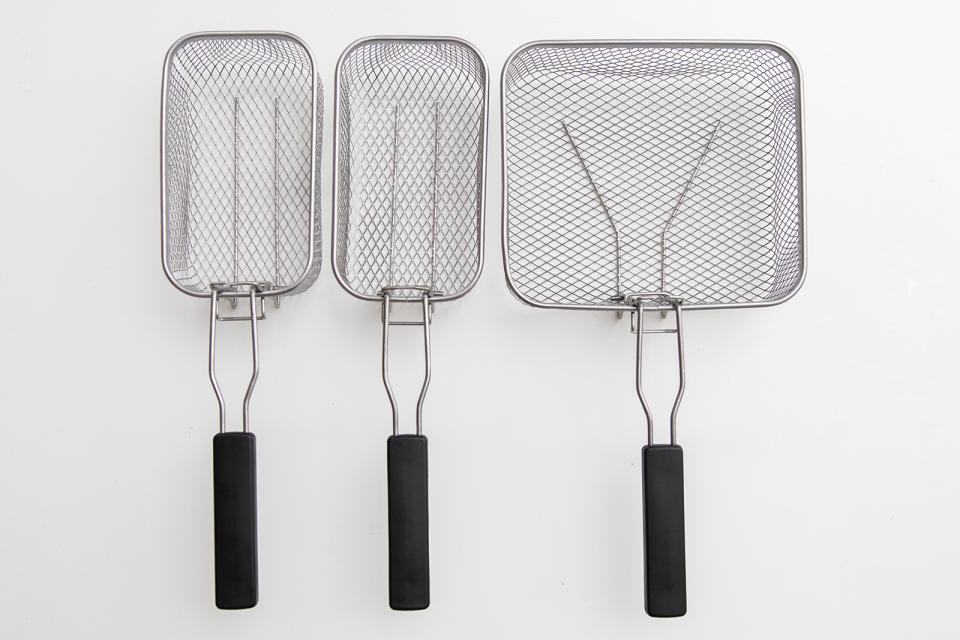
A crowded basket will result in pale, soggy fried food. Filling the basket only halfway will ensure that the food is fully submerged in the oil so it browns evenly. Frying in smaller batches will also help prevent the oil temperature from dropping as much, which will give you crispier results.
Accurate thermostat
A good deep fryer will have a thermostat adjustable from 300 °F to 375 °F, which is the temperature range you'll fry at most often. How quickly the oil heats up depends on the capacity of the unit and the temperature of the oil, but in our tests, it took an average of 13 minutes for 4 quarts of room-temperature oil to reach 375 °F.
We looked for fryers that could consistently reach at least the set temperature, and ideally go a little bit past it, since the temperature drops when you add food to the oil. But many of the models we tested were incapable of reaching 375 °F, even when set to that temperature (see the line graph below). As chef Joseph Simon explained, you'll get better results if the oil stays hot: "Deep-frying really isn't that unhealthy. But if the temperature is below what it should be, depending on what you're cooking, the product can soak in more oil."
Since it's normal for the temperature to dip when adding food to the oil, we wanted to find models that had a quick recovery time. However, we found that the temperature of the oil in most models dropped between 50 and 125 degrees after adding frozen french fries, and kept dropping for the next three minutes or so before slowly working its way back up to the preheated temperature. Spoiler alert: A pot of oil on the stove had the quickest recovery time than any of the fryers we tested.
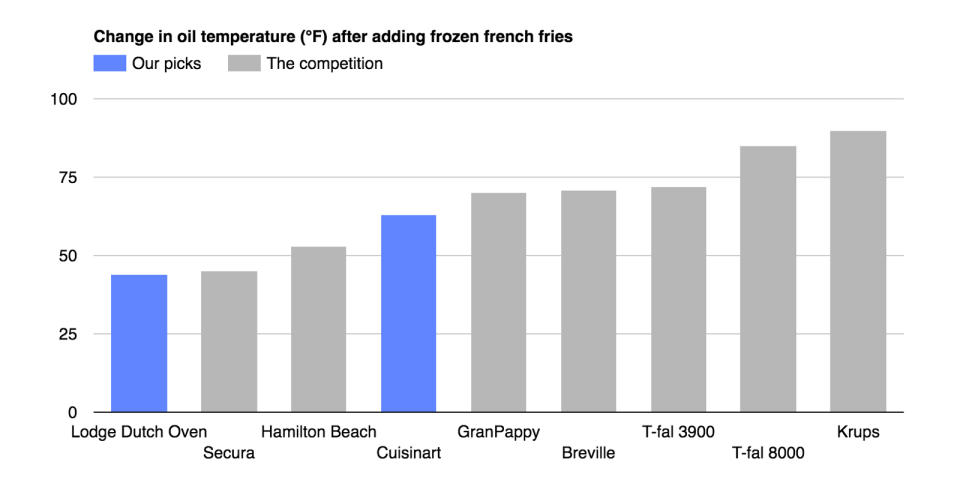
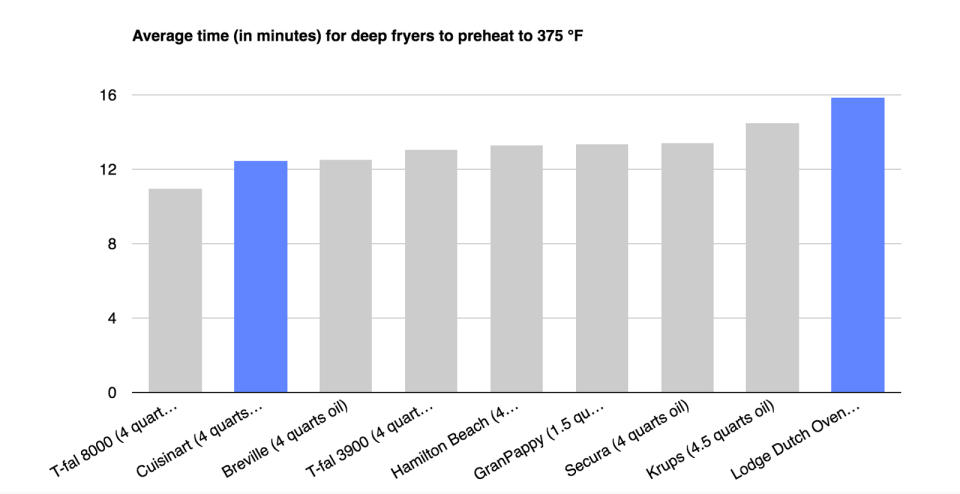
Simple controls
Most deep fryers have a simple dial control to adjust the temperature, while others have digital controls. Some fryers also feature an old-school wind-up 30- or 60-minute timer that dings pleasantly when the time is up (digital models usually have beeping timers). A timer is a nice addition, but it's not really necessary since most people use visual clues (mainly browning) to know when their food is sufficiently fried.
Nearly all deep fryers have a light to indicate that the unit is on. The best models will also have a light that illuminates when the oil has reached a set temperature. Without this feature, you can't be sure the oil has reached the desired temperature unless you use a thermometer.
Digital models have preset functions with programmed temperatures and cooking times for commonly fried foods like french fries and doughnuts. We tested only two fryers with preset functions, the Krups KJ502D51 and the Breville BDF500XL Smart Fryer, but we discovered that the preset times weren't accurate on these models. The Breville has some interesting features such as a two-step fry setting for French fries but ultimately we found a single temperature-control dial was easiest to use. Besides, most people fry food until it's golden brown, not by some arbitrary preprogrammed setting. The frying time will also vary depending on the type, size, and quantity of the food you're cooking.
Durable materials
We looked for deep fryers that have a stainless steel container to hold the oil. A few models we tested, such as the Hamilton Beach 35034 and the Presto 05420 FryDaddy, had containers with an enamel or a nonstick coating. However, we don't see the advantage of these materials. Since the rough steel frying baskets can scratch nonstick and enamel coatings, we prefer containers made from more durable stainless steel.
Detachable safety cords
All fryers come equipped with a short, detachable magnetic safety cord. If something (or someone) becomes entangled in the cord, the plug will immediately detach rather than risk yanking the whole fryer full of hot oil off the counter. However, some of the models we tested had weak magnets on the cord that would release with just a subtle nudge of the cord, like the Breville BDF500XL Smart Fryer. We looked for models that could disconnect easily but stay attached to the unit while frying.
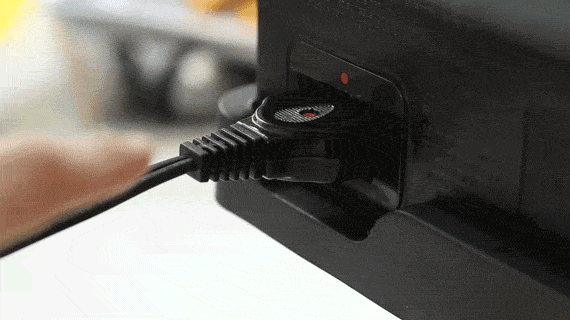
A note on fryer lids and odors
All deep fryers come with a vented lid to let the steam escape while frying. Some manufacturers tout that the lids help cut down on frying odors, but every model we tested stunk up our test kitchen. The Secura deep fryer attempts to remedy the problem by including a "carbon-activated" filter below the vent, but it proved ineffective. However, we took the advice of cleaning expert Jolie Kerr and used activated charcoal to remove lingering frying odors. This was the only method we tried that successfully eliminated the scent. (For more tips on reducing frying odors, see our Care and maintenance section.)

How I tested
I tested eight deep fryers by cooking batches and batches of food, cycling through 8 gallons of oil in all. After purchasing a mountain of bagged frozen french fries (which earned me several concerned glances from the grocery store cashier), I cooked them in each model and tasted them to see if they were crispy and not soggy. Then I made homemade beer-battered onion rings in each fryer to see if the oil stayed hot enough to produce perfectly golden-brown results that weren't greasy. I was also looking to see if the frying baskets provided enough space to prevent the onion rings from clumping together into an unappetizing glob. To see how each model cooked raw meat, I used them to fry frozen breaded chicken fingers. This test showed me whether the fryers could cook the chicken all the way through without overbrowning the exterior breading.
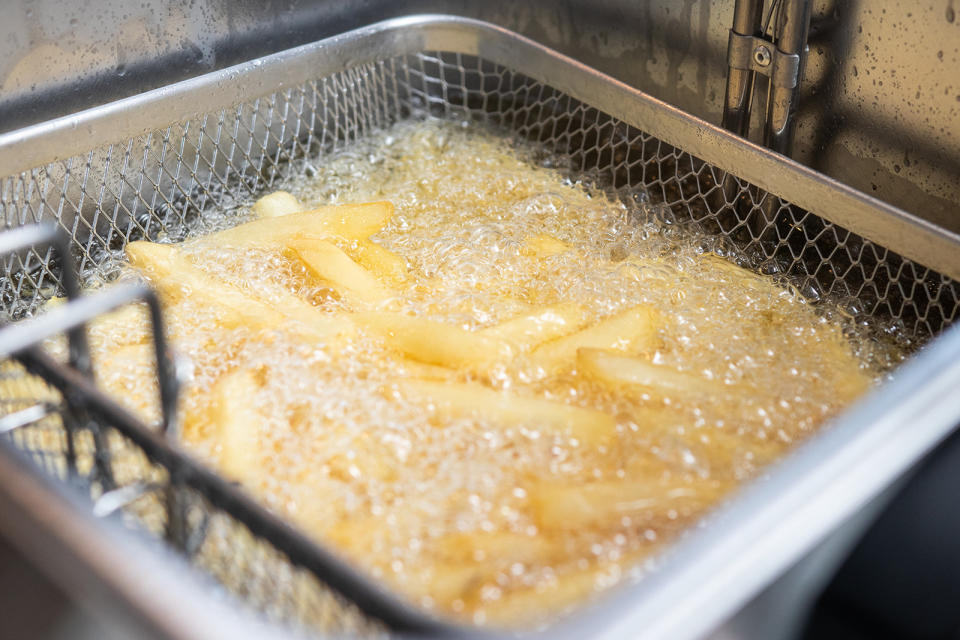
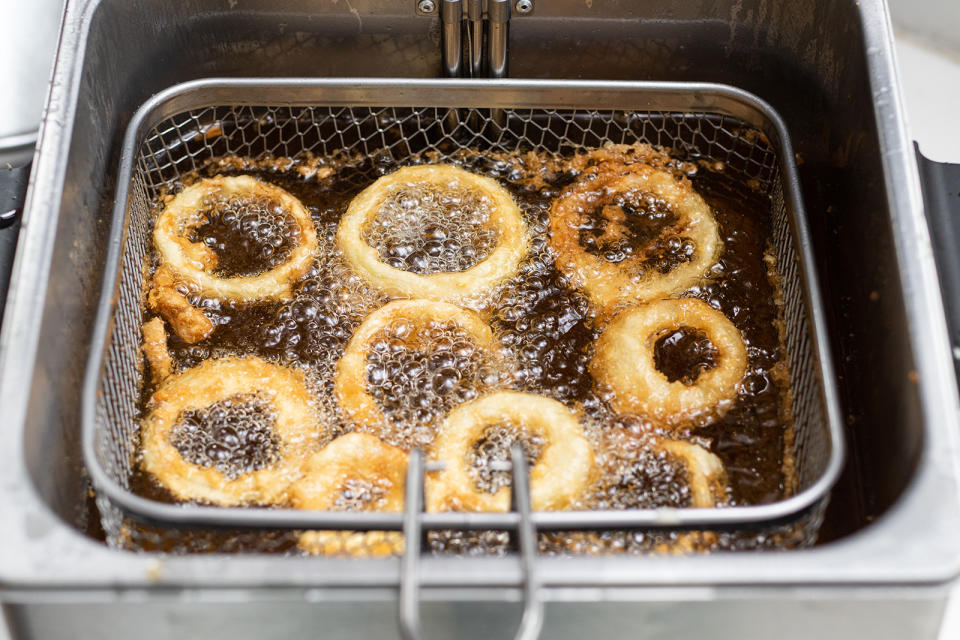
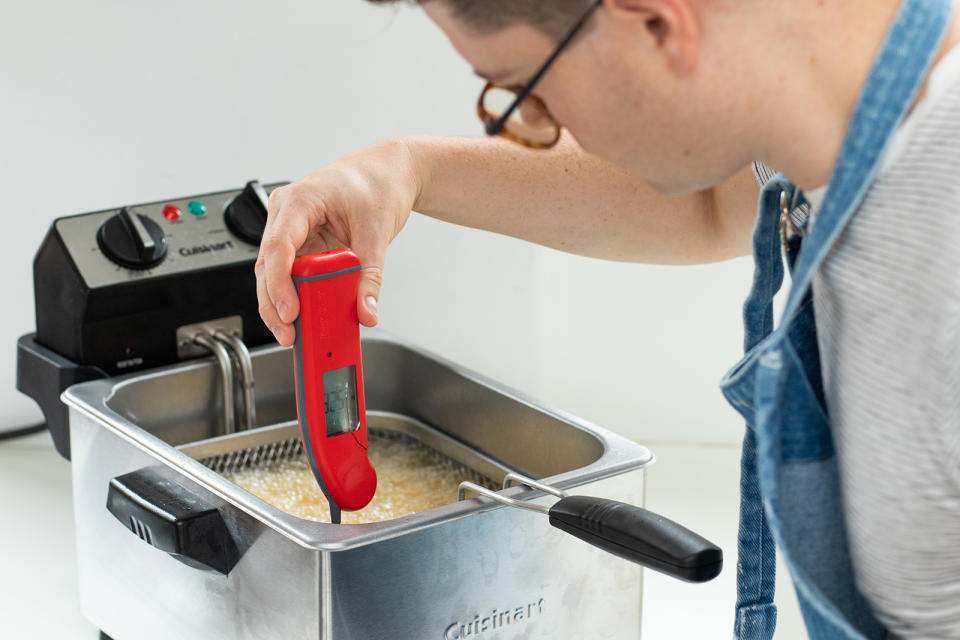
A good deep fryer should preheat relatively quickly, so I timed how long it took the oil in each fryer to reach 375 °F. I also took the temperature of the oil using a probe thermometer to check the accuracy of the thermostats. After adding the food to the fryers, I monitored the temperature using the thermometer to see how much the oil temperature dipped.
I also took into account the shape and size of each fryer to see how much counter space they hogged. Finally, I washed all of the fryer parts by hand several times (if we're counting, that's about 40 separate pieces in all) and can confirm that none of them are a joy to clean. It took some serious scrubbing to get every nook and cranny free of oil. Not to mention, the rough fryer baskets shredded several sponges to pieces in my attempt to get them clean. By the end, I smelled like a french fry and glistened like one, too.
Our pick: Cuisinart CDF-200
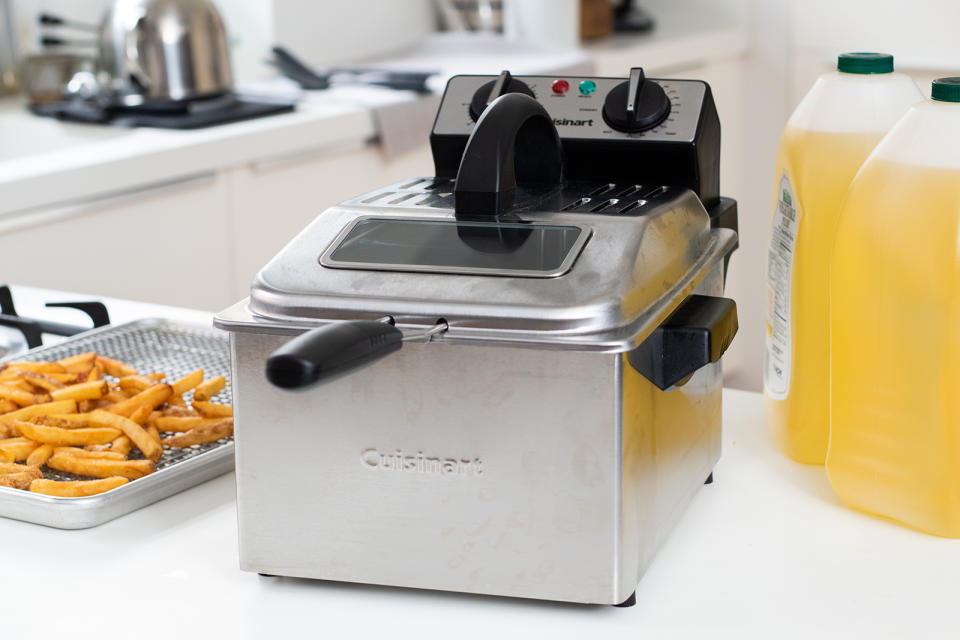
Batch after batch, the Cuisinart CDF-200 consistently produced perfectly golden brown food in our tests. Its superior performance is due in part to its reliable thermostat, which maintained the oil temperature better than most other models we tried. The Cuisinart's clearly labeled temperature-control dial and 30-minute timer are simple and easy to use. We also appreciated that this model comes with just one large frying basket versus fryers with two additional small baskets because it cuts down on clutter, makes it easy to toss food, and works for just about anything you'd want to fry.
When we set the Cuisinart's temperature dial to 375 degrees Fahrenheit, the actual oil temperature reached about 388 °F. That was a good thing: We'd prefer the oil to be slightly higher than what's indicated on the dial, as the temperature will drop when you add food. Impressively, the oil's temperature dipped only about 60 degrees when we added frozen chicken fingers to the Cuisinart. In other models we tested, such as the Krups KJ502D51, the temperature fell nearly 90 degrees. Since the Cuisinart maintains the oil temperature so well, all of the french fries and onion rings we prepared were crispy and cooked to perfection. Frozen chicken fingers were evenly browned, tender, and juicy on the inside.
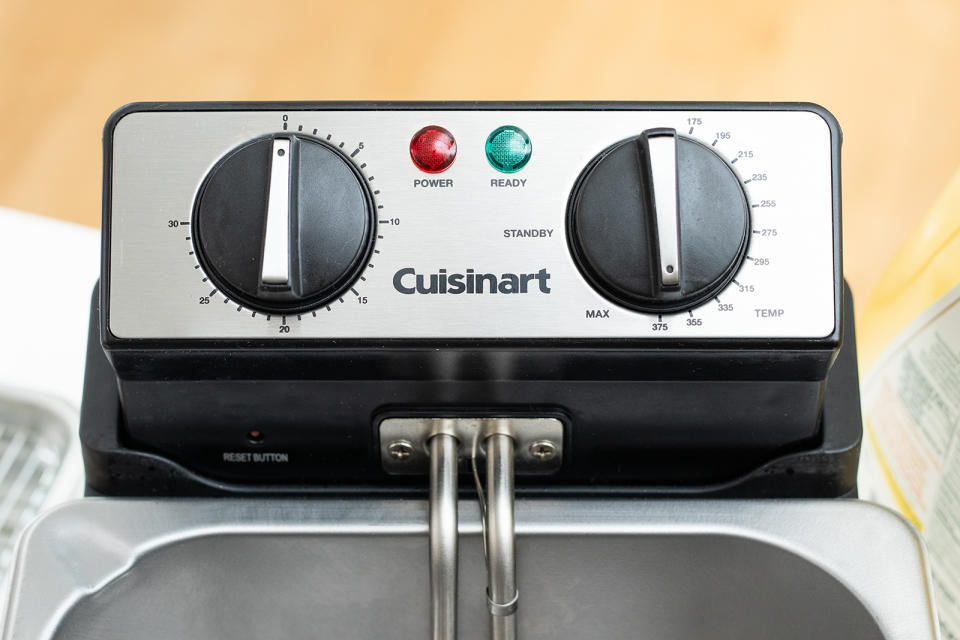
The Cuisinart's control panel is very straightforward. Its temperature-control dial has 11 clearly labeled markings ranging between 175 °F and 375 °F (though you'll likely only set it between 300 °F and 375 °F for most frying tasks). It took about 12 minutes, 24 seconds for the oil to reach 375 °F, which was about 45 seconds faster than the average time it took most models (even ones with smaller capacities) to preheat in our tests. The Cuisinart also has a 30-minute timer that dings to alert you when the set time is up. This model has two lights: A red light indicates that the fryer is on, and another turns green when the oil reaches the preset temperature.
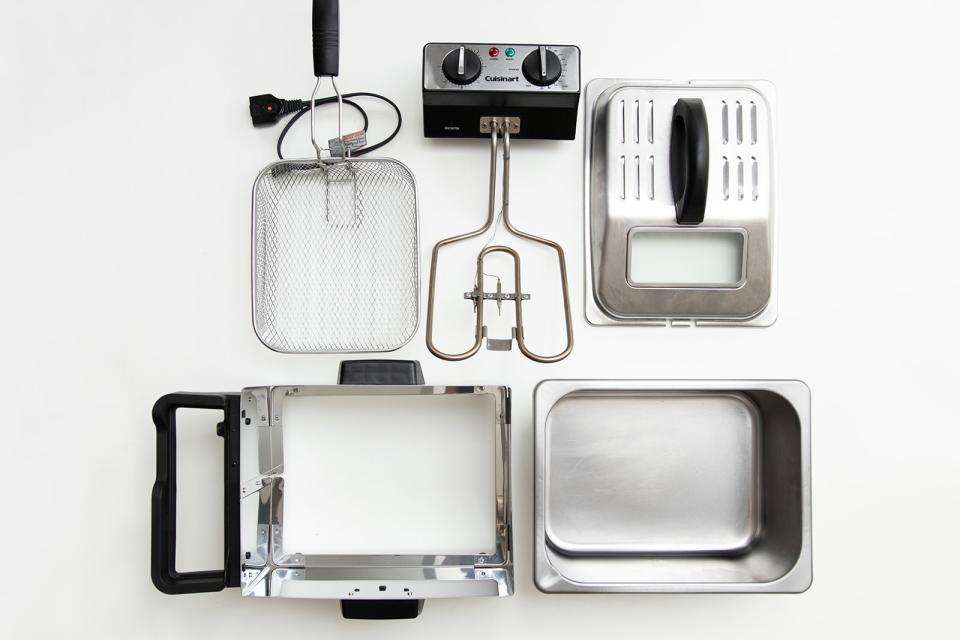
The Cuisinart's large frying basket provides ample space for tossing food during the cooking process. We also liked the detachable handle on the Cuisinart basket, which makes it more compact when storing it in a cupboard. When the handle is attached, it locks securely in place and is comfortable to hold. Some fryers, like the Krups KJ502D51 model we tested, had wobbly basket handles that were awkward to use.
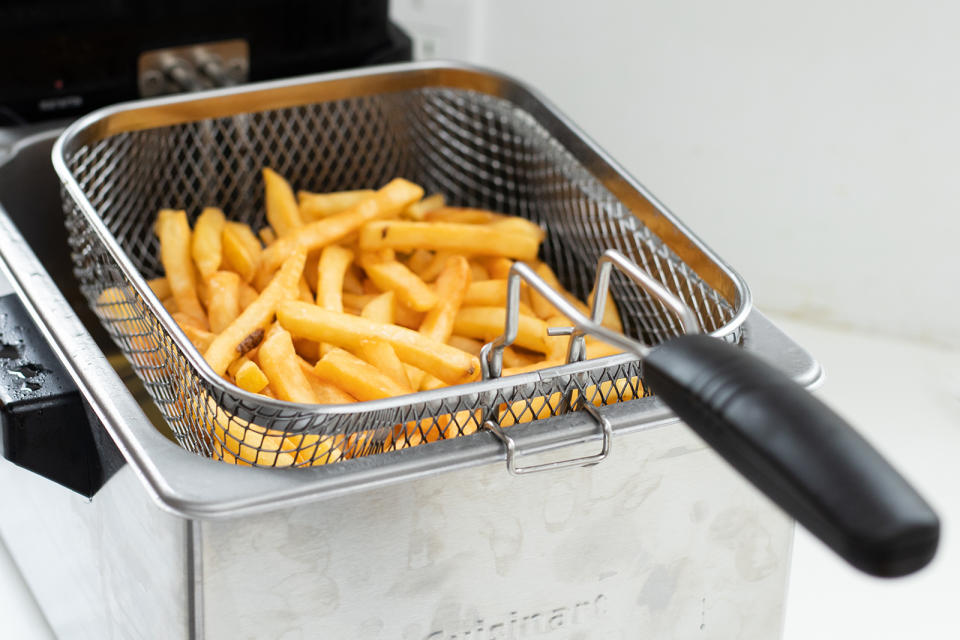
The Cuisinart comes with a three-year warranty, which covers defects in materials and workmanship under normal household use. If you have issues with your fryer under warranty, you'll still have to pay for shipping costs to and from a repair center, which is unfortunate. Contact Cuisinart for specifics regarding repairs or replacements.
Flaws but not dealbreakers
While the Cuisinart did a better job maintaining the oil temperature than many of the models we tested, it still wasn't as good as using a pot of oil on the stovetop. However, none of the deep fryers we tested could maintain a set temperature as well as a pot of oil over a gas range.
The Cuisinart's fryer lid has a window for keeping an eye on your food while it fries, which is unfortunately pretty useless, since the window quickly becomes covered with condensation, preventing you from seeing anything. But we don't recommend using the lid while frying anyway, because the condensation can drip back into the oil, causing it to splatter, when you remove the lid. That said, you should always have the lid nearby whenever frying. If you experience a grease fire, you want to be able to immediately cover the fryer and smother the flames (for more frying safety tips, see our Care and maintenance section).
Like all of the fryers we tested, the Cuisinart will fill your kitchen with nasty frying odors. However, we found that placing a couple of bowls of activated charcoal around the kitchen after frying helped get rid of the smell faster.
The Cuisinart also has a lot of parts that require cleaning, which is tedious to do by hand if you don't have a dishwasher. And we can't reiterate this point enough: Never leave oil in the fryer for long-term storage. It can cause damage to the heating element and will go rancid faster since it still has little bits of food in it. While you can fry multiple batches of food in a row, you should filter the oil after every use if you plan to use it again later. It's messy, labor-intensive, and time-consuming, but a necessary task if you want your oil to last longer.
Also great: Lodge 6-Quart Enameled Dutch Oven and ThermoWorks Dot

Most people don't need a deep fryer in their kitchen and would be better off using a large pot, like the Lodge Dutch Oven. The Lodge maintained the oil temperature better than any of the fryers we tested, and it was far easier to clean. While you can use any large pot for frying, we think the Lodge is best because it's heavy enough to help regulate the temperature of the oil. It doesn't require seasoning like a regular cast-iron skillet, and the interior coating is light enough to see what you're frying. The Lodge's 6-quart capacity is an ideal size for preparing two servings of french fries at a time. It takes more attention and finesse to keep track of and adjust the oil's temperature, but you can easily monitor it using a probe thermometer with a pot clip (sold separately), or an inexpensive clip-on deep-fry thermometer.
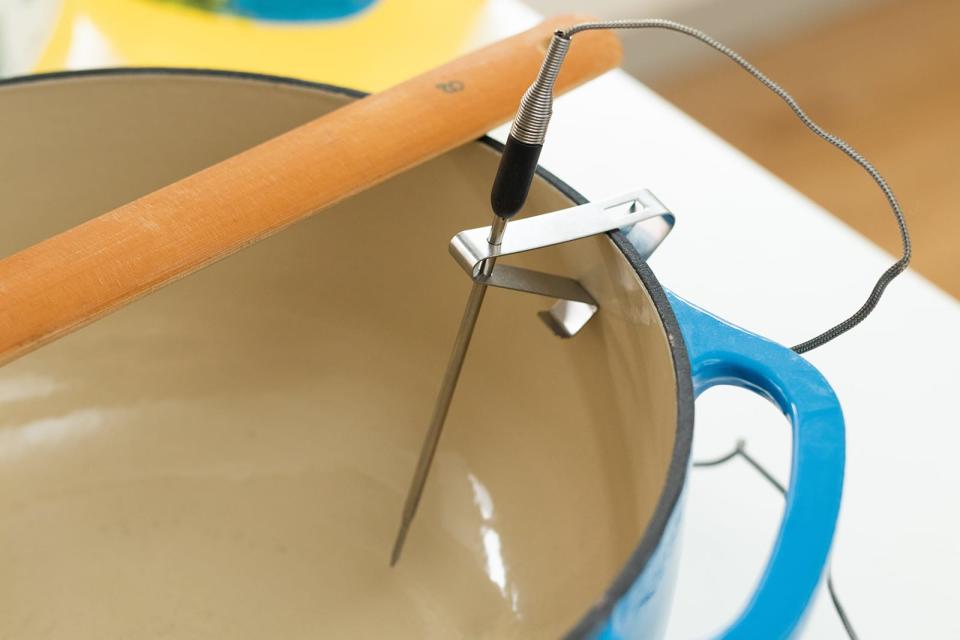
The Lodge, which is the top pick in our guide to Dutch ovens, is an excellent pot to use for frying because it has great heat retention to help regulate the temperature of the oil. Chef Simon told us, "A thin pot will get hotter and there's going to be more hot spots." Though it took the Lodge a couple of minutes longer to preheat the oil than the Cuisinart, it did a far better job maintaining the desired temperature throughout the cooking process. The food we fried using the Lodge cooked noticeably faster than the Cuisinart, but that's a minor point since the Lodge took longer to preheat. Overall, the results from both the Lodge and Cuisinart were largely the same.
The Lodge is also wide and deep enough for most home frying tasks. Obviously, there's no max fill line on the side of the pot like on the Cuisinart deep fryer, but a good rule of thumb is to never fill the pot more than halfway with oil (otherwise it could overflow when you add food). Though you can use only about 3 quarts of oil in the pot at a time (as opposed to 4 quarts in the Cuisinart), there's no heating element or fryer basket to take up space in the Lodge, giving you plenty of frying capacity. The curved edges of the pot also make it convenient for scooping out fried food using a spider or a large slotted spoon. And the Lodge isn't just great for deep-frying it's a versatile pot that can be used for a number of preparations, including soups, stews, braises, and sauces. It's also safe in the oven up to 500 °F.
Any cast-iron pot works well for deep-frying, but the porcelain enamel coating on the Lodge Dutch oven is easier to care for and maintain because it doesn't need to be seasoned like a cast-iron skillet. We also prefer the Lodge's light interior coating over bare cast iron because it's easier to see the color of the food you're frying and the quality of the oil. That said, we'd recommend using a 12-inch cast-iron skillet for shallow frying tasks, like cooking fried chicken (see our guide to cast-iron skillets here). For small-batch deep frying, you can also use a 3-quart pot filled halfway with oil (see our guide to cookware sets here).
Frying with a pot on the stovetop requires more attention to regulate the temperature of the oil, but using the ThermoWorks Dot probe thermometer alleviates any guesswork. In our guide to the best probe thermometer, we tested 11 models and the Dot was the fastest to read temperatures accurately. At 4 ½ inches, the Dot's probe is also long enough to be fully submerged in a pot of oil. We recommend purchasing an inexpensive pot clip to keep the probe in place while you fry. With its wide temperature range, this thermometer can also be used for candymaking or meat cooked in an oven or on a grill.
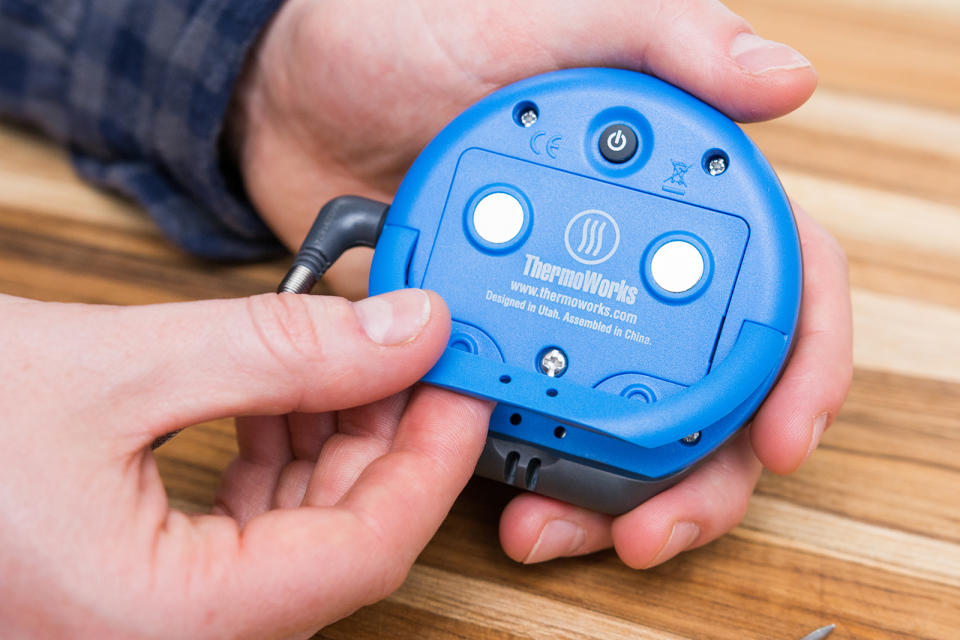
The Dot has straightforward controls with an alarm that can be set for a specific temperature. For instance, you can set the Dot to 375 °F for frying, and the alarm will beep to alert you when the oil reaches that temperature. The large digital screen, which reads both Fahrenheit and Celsius, makes it easy to monitor the oil temperature.
The Dot comes with a two-year warranty, and the probe is replaceable. Lodge offers a limited lifetime warranty (PDF) on all its enameled cast iron.
Care and maintenance
Using your deep fryer
Before using your deep fryer for the first time, wash the oil container, lid, and baskets, all of which are dishwasher safe. Never immerse the control panel that's attached to the heating element in water. Simply wipe it clean with a sponge after use and carefully rinse it. Be sure all of the pieces are thoroughly dry before using them.
We recommend removing the oil from the fryer after each use. If you plan to reuse your frying oil, it should be strained and stored in a sealed container to keep it from turning brown and smelling rancid and fishy (more on this below).
All of the fryers we tested have handles on the side, which makes them easier to carry, but be advised: You should never move a fryer when it's full of hot oil.
Also, avoid using an extension cord with your deep fryer. The power cords are intentionally short to prevent accidents caused by tripping or entanglement. Always position the fryer on a clean, stable surface out of the reach of children.
Frying basics
Choose an oil with a high smoke point, such as peanut or canola oil. Most manufacturers do not recommend using animal fats such as lard or duck fat in a deep fryer because of their lower smoke points.
Always add at least enough oil to meet the minimum oil line on the inside of the container. However, in most cases you'll want to fill the fryer to the max line to make sure your food is fully submerged in the oil. Never add oil above the maximum fill line, as the oil level will rise when food is added and you don't want it to overflow.
Avoid dropping food into a deep fryer from up high, which can cause splatters and burns. Use the fry basket or a spider to gently add food to the oil.
For battered foods, lower the basket into the oil first, then add food to the fryer using tongs, or place it close to the surface of the oil and let it fall away from you. If you add the battered food to the basket first and then lower it into the oil, it will clump together into an unappetizing mass and stick to the bottom of the basket.
To avoid soggy or overly greasy results, don't crowd the fryer with food and never fill the basket more than halfway. This is especially important when frying frozen food, which will lower the oil temperature more than room temperature or refrigerated food.
After using your deep fryer, unplug it and allow the oil to cool completely before filtering it.
According to Simon, "If your oil gets low, you're absolutely not supposed to top it off with fresh oil because it can make it look cleaner than it is and there's a higher chance of it combusting."
For more information regarding frying techniques and safety, check out the USDA's website.
How to filter used oil
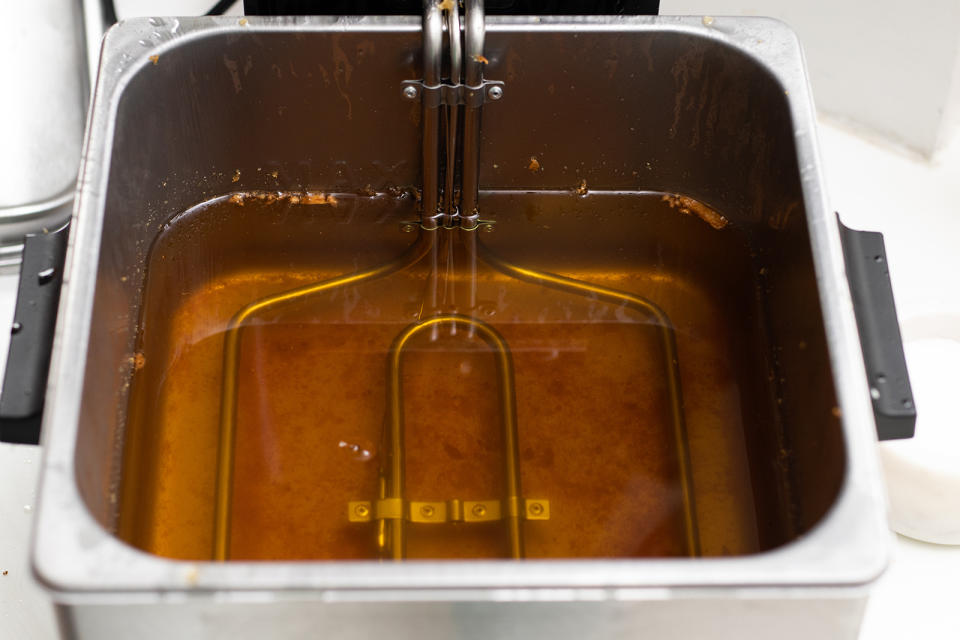
If you plan to use your oil for several frying sessions, you should filter it before storing to slow the process of degrading. Home fryers don't have a "cold zone" the area below a heat source where food particles settle without burning which is common in many commercial fryers. In a home fryer, any food that falls to the bottom will burn and turn the oil rancid faster. Here are some tips for filtering oil so it will last longer:
Once the used oil has cooled it can be filtered. Pour it through a cheesecloth or paper towel lined fine-mesh sieve (you can also use a #6 coffee filter) placed over a stockpot or other large container. Using a funnel, transfer the oil back to its original container or another receptacle (see our picks for the best dry food storage containers), and store it in a cool, dark place away from heat.
The same oil can be used several times for frying, but breaded or battered foods make the oil degrade faster. The same goes for fish. You'll know it's time to discard the oil when it begins to foam, becomes dark and cloudy, or smells fishy.
The best way to dispose of used oil is by pouring it into a disposable metal or plastic container with a sealable lid before throwing it in the trash (once it has cooled, of course). Never pour oil down the drain because it can clog your pipes.
How to reduce frying odors
Jolie Kerr, cleaning expert and host of the podcast Ask a Clean Person, suggests using activated charcoal to rid your kitchen of any lingering fryer odors. She told us in an email interview, "Activated charcoal, which also goes by the names active charcoal, active carbon, and activated carbon, is a great odor absorber and eliminator. It's available in brick form or sachets, or you can buy loose activated charcoal from a pet supply store (it's used in aquariums) and decant it into a bowl." We placed bowls of activated charcoal around our test kitchen after frying, and they effectively reduced the frying odor.
Frying safety
According to the National Fire Protection Association, "Cooking fires are the number one cause of home fires and home injuries." Never leave the kitchen when frying with oil. If the oil begins to smoke, immediately turn off the fryer. In case of a grease fire, here's what to do:
Place the fryer lid or a metal baking pan over the oil container and turn off the machine (or burner if you're cooking on the stovetop). Do not attempt to remove the cover until it has cooled.
If you don't have a lid or a metal baking pan nearby, small grease fires can usually be smothered with lots of baking soda. NEVER throw water on a grease fire. Water will vaporize instantaneously when it comes in contact with burning oil, creating an explosion of fire. (This horrifying yet educational video demonstrates what happens when burning oil and water mix.) If the fire is bad, you can use a fire extinguisher that's suitable for grease fires, such as our pick for the best fire extinguisher.
If the fire can't be extinguished, evacuate everyone from your home and call 911 from a safe location.
The competition
We liked the compact size and deep-frying basket of the Breville BDF500XL Smart Fryer, but only one out of three models we tried worked. The first model was dead on arrival, and the second model died after turning on twice. Neither model could be resuscitated, even after hitting the reset button on the back of the control panel. The third model we tested worked well, and we appreciated that the digital interface tells you the current temperature of the oil, but we expected more from a $130 piece of equipment.
The T-fal FR3900 made nicely golden-brown breaded chicken that was tender and juicy. However, the basket doesn't sit flat inside the fryer because the handle hits the edge of the bin, causing it to angle forward. Because of this design flaw, the fries we prepared weren't completely submerged, so we had to toss them more frequently and cook them longer. Also, the basket handles weren't as sturdy as our main pick, the Cuisinart CDF-200.
The expensive T-fal FR8000, which has a mesh-covered drain on the bottom of the oil bin that filters used oil into a plastic storage container below the fryer, looks great on paper, but unfortunately wasn't as effective as we'd hoped. In our tests, the oil filter worked well for the most part, but it leaked some oil on the counter. This model also didn't maintain the oil temperature as well as the Cuisinart, leading to food that was noticeably greasier.
The Hamilton Beach 35034 did well in most of our tests, but we worry that the thin enamel coating on the container will eventually flake off. We prefer the stainless steel bin that comes with the Cuisinart. The Hamilton Beach has three baskets one large and two smaller ones meant to be used side by sideâ€"but we think the single big basket is sufficient.
We didn't find the digital presets on the Krups KJ502D51 to be very helpful. All but one setting is programmed to 375 °F, with only slight variations to the cooking times. Besides, most people fry food until it has reached the desired color, not based on a predetermined time. The basket handles were also very wobbly on this model.
The Secura Deep Fryer took several minutes longer to preheat than the Cuisinart. And its carbon-activated filter on the lid did nothing to cut down on frying odors. This model also comes with three frying baskets, which takes up more space in a cupboard.
The Presto 05420 FryDaddy Electric Deep Fryer is different from the other models we've tested because it's essentially just a small pot that heats oil without a control to adjust the temperature. Its 1-quart capacity is so small you can only fry a handful of french fries at a time, which is pretty inconvenient if you're trying to prepare enough food for a family. For small-batch frying like that, you're much better off using a pot you already have in your kitchen, which will allow you to control the temperature more easily. The FryDaddy also comes with a plastic lid for storing the oil in the pot. However, as we've said earlier, we don't recommend keeping used oil in the pot unless you've filtered it first, otherwise it will go rancid faster.
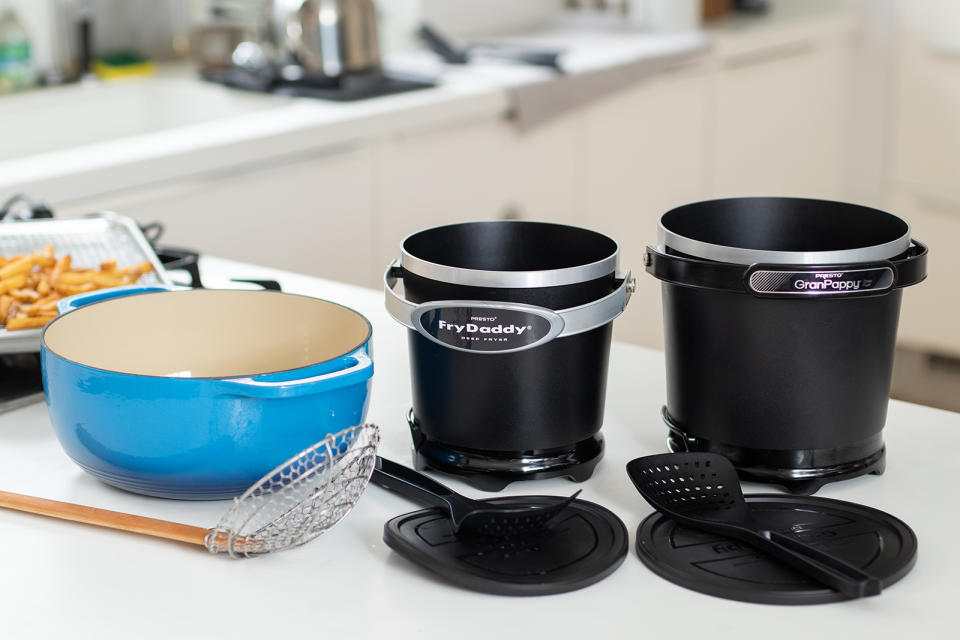
Like the FryDaddy, the Presto 05411 GranPappy Electric Deep Fryer lacks a control to adjust the temperature. Unless you use a thermometer, there's no way to know the temperature of the oil. In our tests, the oil measured around 375 °F, which is great for french fries and onion rings, but far too hot for chicken tenders. The breading was burned on the chicken fingers we fried, while the center remained completely raw. And while the GranPappy is half a quart larger than the FryDaddy, it's still too small for most frying tasks. We were able to prepare only one serving of french fries at a time using the GranPappy. The plastic spider is oddly shaped and made it difficult to retrieve food from the fryer. Also, we don't see the benefit of the nonstick coating on the interior of the pot, which will eventually deteriorate over time.
This guide may have been updated by Wirecutter. To see the current recommendation, please go here.
When readers choose to buy Wirecutter's independently chosen editorial picks, Wirecutter and Engadget may earn affiliate commissions.
